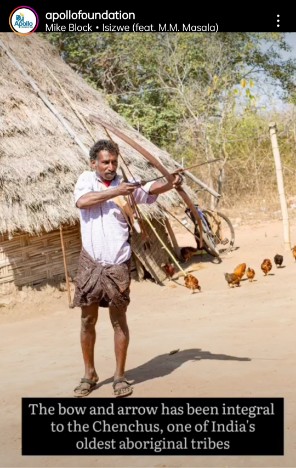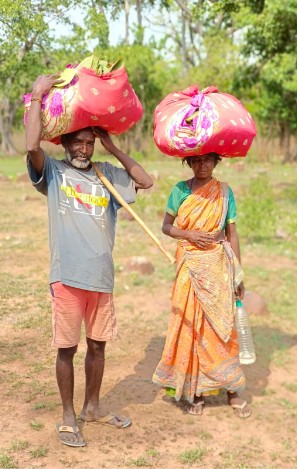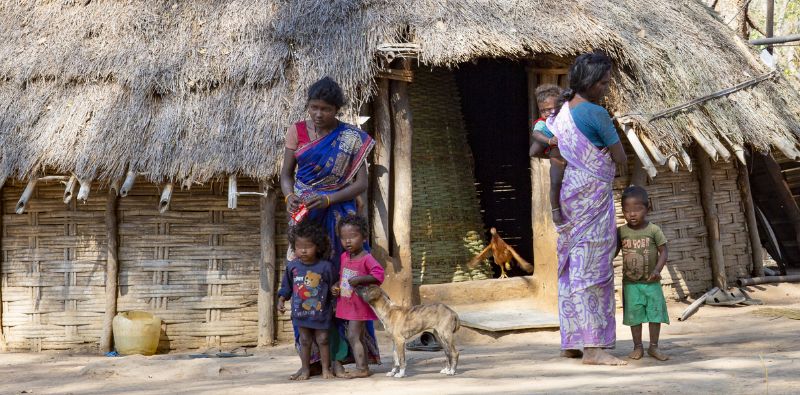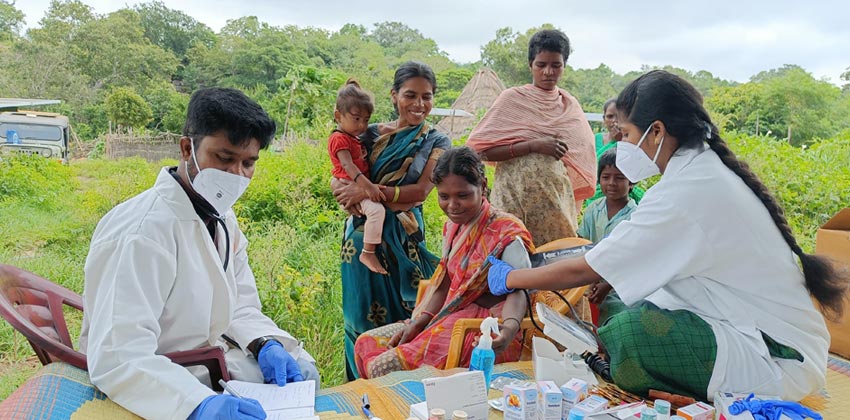The incessant clucking of chicken breaks the silence in the Amrabad forest. The loudest squawk comes from inside C Lingayya’s home in Bairapur penta where a hen is roosting inside a cloth swing.
As sunny as Amrabad is in the summer, the interior of the 175-square foot hut is dark and cool. “I made this house myself, using bamboo and grass I collected from the forest,” says Lingayya. There is no overt pride in his voice – as a member of the Chenchu tribal community, this is a common practice. He relies on the forest for almost every aspect of his life; his house is just one of them.
The way of the forest
The Chenchu tribal community is spread across the Nallamala hills, which are home to two tiger reserves: Nagarjunsagar Srisaliam and Amrabad, in Andhra Pradesh and Telangana, respectively. There are over 50,000 Chenchu tribals living in settlements called pentas, inside the forests. Each penta is home to up to 30 households and separated from each other by over 20 km.
As hunters and food gatherers, the Chenchus are one of India’s oldest aboriginal tribes, classified by the Government of India as a particularly vulnerable tribal group (earlier referred to as primitive tribal group). Even today, their lives are linked inextricably to the forests. “We have to walk deep inside the forest to gather tubers, roots and fruits for both eating and selling. Sometimes, we take our kids with us. Chenchu children begin exploring the forest as young as age 5,” says Lingayya.
The 40-year-old says his family has been living in the forest for as long as he can remember. As a child, he would accompany his father into the forest to gather the nannari flowers, and today, his son accompanies him.
“We have seen tigers, leopards, bears, wild boar. If we think they might charge at us, we make loud noises using hammers so that they leave us be,” he says. Learning how to co-exist with their wild neighbours in the forest comes organically for the Chenchus.
While earlier they would hunt for small prey such as monitor lizards, deer, and some types of small birds, today, with tighter government protection laws, that doesn’t happen. Lingayya shows off his knives with decorative hilts and the bow and arrow made of bamboo his forefathers used. He retains the skill of archery – Lingayya draws an arrow, places it in the bow, pulls it back and aims at a tree. With a satisfying twang, the arrow finds its mark.

Forest know-how
Given their knowledge of the forest, in some parts of the NSTR, Chenchus have been hired by the forest department to help protect wildlife against poachers and hunters. In Amrabad, Total Health is training the tribe in the use of a geographical information system (GIS). With their knowledge of every naturally occurring landmark in the forest (like water bodies), we are developing GIS-based maps of the forest’s wildlife corridors and conservation hotspots. Tribal rehabilitation is an important part of the programme.
However, for their main source of livelihood, most Chenchus depend on either gathering forest produce or agriculture. On an average, a Chenchu walks about 20 km a day inside the forest, collecting nannari flowers, mahua flowers, honey, and roots such as chenchu gadda, nula gadda, and adivi gadda. What they collect depends on the season: the roots during the rainy season, raw honey in summer, in particular from Sarrigoda – a colony of bee hives built on rocky hills. The produce is sold outside to either the government run Girijan Co-operative (set up for tribal produce) or independent buyers.
For T Balamma, it is the madupaku leaf that will fetch her sustenance for the day. We meet her in the late afternoon as she returns to Pulliapalle penta after a day of labour in the forest. Holding a bundle of betel leaves over her head she says, “To collect this bundle, I have been in the forest since 6 am. If you dry these, you can stitch plates out of them. This bundle will sell for Rs 300 in Mannanur (a village outside the forest).”

Today has been especially fruitful for her as she is accompanied by her husband — an occurrence not that frequent, given his addiction to alcohol. Addiction is a major issue in Amrabad, more so among men, and for many Chenchu women of Amrabad, the forest supports them even when their partners can’t.
Not everything they gather is sold. Often, Chenchus depend on the flora around them for daily survival. Ganesh, who works as a guide for the forest department, takes us on a trek through the Amrabad forest. He was part of the cohort that Total Health trained as naturalists. As he walks along the red dirt track, he describes the trees we find along the way. He plucks a black berry and tears it open to extricate the brown seed. “These are chilla ginjalu. You can drop some in water to purify it before drinking. When we walk long distances in the forest, we suck on them to quench our thirst,” he says, even as we chance upon bear droppings. He’s able to tell when the bear came this way simply by examining the poop!
Then there is the nilamari herb, a traditional fishing bait. “If you mix this in pools, the fish become drowsy and rise to the surface of the water – makes it easier to fish,” says Ganesh. Some trees help in making houses and tools, such as the Narayapa or Peddayapa tree – its outer bark is used to make ropes. The Peddayapa is also a source for honey.
In the past year, as the Total Health team has set up health camps and awareness sessions inside pentas, it has slowly gained the confidence of the tribal residents. Our doctors learnt of the different ways the Chenchus fight off infections – the leaves ingested and vomited out in case of fevers and snakebites, the herbs applied over rashes and so on.
A life outside
Despite being so at home in the Nallamala forest, over the years, governments have attempted to coax the Chenchus to move outside the forest, so as to fortify the wildlife corridors. Brick and mortar houses have been constructed outside the forest for them to relocate.
It is here that the Chenchus are caught between two worlds. Parvathyamma, a resident of Thirumalapur penta (a government-constructed tribal colony outside the forest) explains the situation: “The only reason we move out of forests is because we want our children to have an education good enough for them to join the mainstream if they wish to. Otherwise, if we think of just ourselves, and the ease of our daily lives, we would prefer to stay inside.”
“It is going to be difficult for us to come out. A lot of times, after coming outside, people get addicted to substances like alcohol available more freely there,” says Kottaiyya. The 31-year-old himself moved out of the forest 10 years ago. “When we were starting a family, we decided it would be best to give our children a better education than we had,” he says. The Mannanur government school only provides education up to Class VIII. His son is now at a hostel in Hyderabad.

Kottaiyya is the first one from his family to move out; they had been living in Komman penta for decades. “For 2 years, I worked as a driver for the government, taking vehicles into the forest. However, we never become permanent employees – it is always an outsourced job that gives daily allowance,” he explains. “Agriculture, to me, seemed more reliable.”
His penta is situated in the dip between two hills, and so, receives a fair bit of rainfall. He and his family grow up to 100 quintals of cotton in the lands there.
With tribal development as his focus, Kottaiyya is one of the leaders in the area. Six months ago, he was instrumental in getting Rural Development Trust to establish solar lights in houses in 10 pentas. Until two years before that, the pentas did not have electricity, relying only on lamps and bonfires. “I am planning to contest elections for the Amrabad sarpanch. I think development for us Chenchus can only happen while we are living inside the forest, co-existing, as we always have.”


